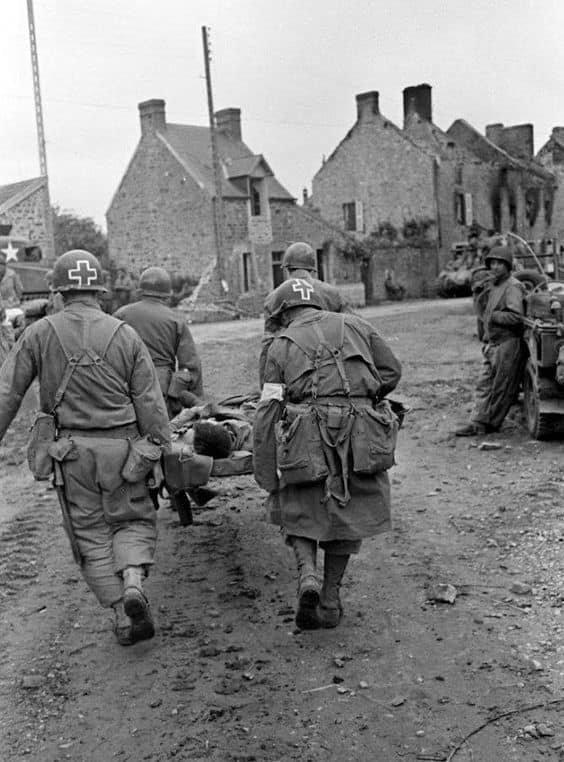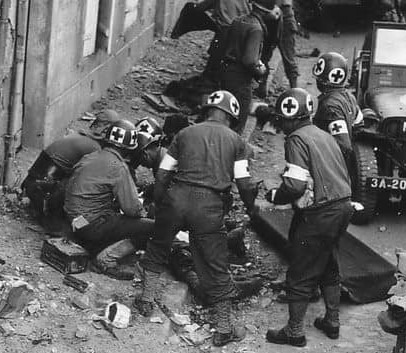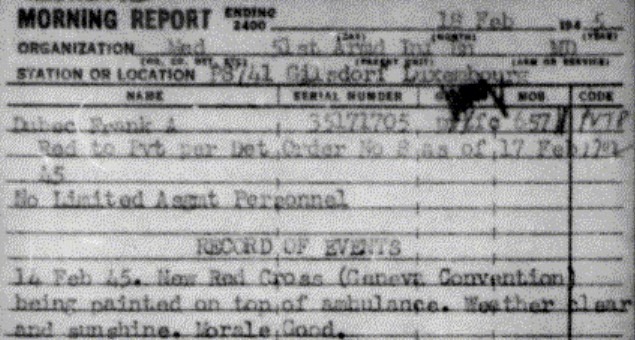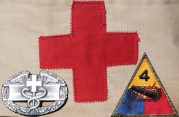In many of the photos and films taken in the European Theater of Operations, we find medical personnel and vehicles marked with Geneva Convention Red Crosses.
The medics found that, generally, the Germans followed the Geneva Conventions on the treatment of personnel and equipment marked as non-combatants.
For this, the Army had the brassards as the official sign of medical personnel and red cross flags for medical vehicles and installations.


Helmets
After repeated claims by Germans taken prisoner in Normandy, that they often could not see these brassards, many medics started to use more and better visible red cross markings. They often started wearing brassards on both arms and they painted red crosses on their helmets.


Note all the different styles and sizes of red crosses.
Even within the same unit, there were variations in the style and size of red crosses. As we can see in this photo, showing medics of the 4th AD in Normandy. We can see the round and square white backgrounds. Note also the double brassards, worn by at least two medics in this photo.

It is interesting to note that the application of red crosses on helmets did not become Army policy during WW2.
In fact, in the documents in my research, I have found several documents stating that the Third Army (under orders of the 12th Army Group) instructed its personnel to remove the red crosses on their helmets.
Journal of the Division Surgeon, dated 25th Sept, 1944:

Journal of the Division Surgeon, dated 31th Oct, 1944

Morning Report 46th AMB HQ, dated 27th Sept, 1944

According to Medical Services in the ETO, Page 372:
“Late in November the 12th Army Group, at the request of the Ninth Army surgeon, formally authorized medical troops to paint large red crosses on white fields on their helmets.”
This authorization reached the 4th Armored Division on December 4th, 1944, in Circular no. 85 from the Third Army as noted in the Division Surgeon’s Journal:

These instructions can help us date the images of the 4th Armored Division medics.
In photos and films taken before September 25th, 1944 we can find all sorts of different designs for the red crosses on helmets.

Images taken between September 25th, 1944 and December 4th, 1944 show us medics wearing their brassards, but without red crosses on their helmets.

And finally, images taken after December 4th, 1944 show us the “standardized” helmets in all the Third Army units.
Medics of the 4th Armored Division

Medics near Bettendorf, Luxembourg.

Note the number on top of the helmet. This was the same number that was on the medics identification card and that was stamped on the back of his brassard.

Vehicle markings
I have found this in the 51st AIB Medical Detachment’s morning report of October 29th, 1944:

The first mentioning of vehicle markings being repainted in the morning reports of the Medical Detachment 51st AIB is on February 14th, 1945. This is part of several consecutive reports of repainting markings on vehicles and helmets during this period.


This could suggest that the red cross markings on the vehicles of the medical detachment were removed between October 29th, 1944 to February 14th, 1945.
But from this photo, taken during the Battle of the Bulge, we know that this was not the case:

So, what happened?
Well, I believe that the morning report of October 29th, 1944 ties in with the October 31st, 1944 entry in the Division Surgeon’s journal.
I think the Third Army, maybe under orders of the 12th Army Group, brought the order of September 25th, 1944 to the attention of the divisions again. I don’t have the original orders, so I don’t know whether they only ordered the removal of the red crosses from the helmets or also ordered the removal from vehicles.
It is possible that the clerk of the medical detachment typed “vehicles”, but was meant to type “helmets”. We just don’t know.
We do know that the repainting of vehicle markings in February 1945, is a consequence of a secret military operation that took place between January 10th and January 13th, 1945.
During this period, the 4th Armored Division was ordered to remove all vehicle markings and shoulder patches. With all these markings removed, the division moved from the vicinity of Bastogne, Belgium to the border region between Luxembourg and France.
This move was done in cooperation with the 23rd Headquarters Special Troops. This unit, better known as “the Ghost Army”, was specialized in deception. It portrayed American units, fooling the Germans into thinking that this American unit was located somewhere it was not.
The operation with the 4th Armored Division was called Operation Leglise. You can read more about this operation, and the Ghost Army on this website.
4th Armored Division Combat History:


The secrecy surrounding the actual location of the 4th Armored Division was lifted on February 8th, 1945. This allowed all units to repaint all markings on their equipment. They could also start wearing the division patch on the shoulder again.
This is what we see happening in the February reports of the medical detachment.
With freshly painted markings, the 4th Armored Division prepared itself for a new offensive. This would take it all the way to the Rhine, and after that, to victory.


Much interest for me…learn what i can…that works